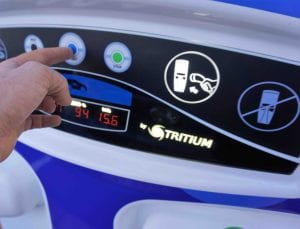I read a hell of a lot but honestly, I rarely get time for books. This weekend however, I found myself hiding from my family so I could gorge on a truly historic book called “Power in Flux”, my first ever Kickstarter purchase.
If I’m honest, as I have been reading this book the hairs on the back of my neck have been standing up – because I realised I’m reading “a historic first book about the history”, and importantly it was only recently finished, so is very up to date.
Ostensively, it’s about “the history of electric motorcycles” but author Ted Dillard has captured a much wider and more profound story in this must read book.
Whilst the evolution of electric motorcycle development has me glued to my couch, a deeper part of the story is about technological development, innovation, start ups, energy storage, carbon emissions and fascinatingly, how the world of electric motorcycles in intrinsically linked to all these fields. For a variety of reasons, electric motorcycles are like a canary in the coal mine.
The story starts by describing the evolution of Integrated Circuits into today’s mind-blowingly powerful digital devices. Early pioneers like Mike Corbin set an electric land speed record that lasted for 30 years (265kmh in 1972!) using military spec gear and frighteningly dangerous and rudimentary knife switches to control the energy being delivered from its silver-zinc batteries.

The ensuing decades saw slow but steady progress by a group of inventors scattered around the world with one highly poignant spin off being the development of the Agni motor in the 1990’s, which remains one of the most powerful and efficient (if unreliable) axial flux DC electric motors made. My 2010 Zero motorcycle featured one of these very motors.
Over the 1990’s the development of the core technology – motors, Integrated Circuits and batteries advanced so rapidly that it arguably was the very same reason that so many incredible electric motorcycle start-ups – some very well funded – went bust and why electric motorcycles haven’t reached mass market deployment yet.
As it turned out, because weight and space is so limited on motorcycles, it became the perfect testing ground for development. If you could fit your batteries and motor in a motorcycle chassis and they could survive the inevitable vibration and weather impacts, you were probably on a winner for wider use.
Battery storage is of course one of the major elements of this entire story and I probably shouldn’t have been surprised to learn from Dillard most of the (successful) Lithium batteries chemistries used today have a very closely related development history.
The time line of this development is fascinating and a who’s who of technological evolution and development including names Like Motorola, Sony, LG, Dow, Ford, Exxon, GM, Mugen and a slew of Universities from around the world. The batteries used in my 2014 Zero electric motorcycle are a direct descendant of all of this work and have served me perfectly for 32,000kms already.
The tight knit community of experts in this field should also be of no surprise. Tesla, Mission Motors, MotoCys, Zero, Brammo, Harley Davidson (Livewire) and a host of other well known electric brands have shared much of the genius over the years as technological innovators tried to find gainful employment in a volatile industry with insufficient volume to be real – yet.

On this topic Dillard describes how revolutionary companies and individuals have attempted many different technological paths and business strategies to bring their products to market. It was wonderful to see no less than several chapters dedicated to Australian companies and individuals featured too. The detail and insight into some of the world-first electric motorcycle engineering experiments undertaken right here in Australia is astounding.
The record breaking results achieved by Newcastle’s ElMofo, got a mention although it was a pity team owner Brett Sutherland’s short lived but generous efforts with an ex-factory Brammo and recent sprint car racing was overlooked.
Catavolt’s amazing experiments and decent International results with hub motors were covered and innovative privateer builder Danny Ripperton’s incredible engineering prowess is also covered. It has also stumbled over the “profoundly dangerous” 700VDC Voltron, made in Perth which remains one of the only bikes of such a voltage in the world. I was fortunate to see this bike during construction at a custom workshop and it is truly a site to behold.
Dillard has done an incredible job cataloguing what has to be the most definitive technological story, glossary and development time line of the electric motorcycle imaginable.
The other thing that struck me about this story is how sometimes the most powerful signals of inevitable change are so obvious they are invisible. Take the humble electric motor for example. Around the average home, you might have 2 or 3 combustion engines – a car or two, a lawn mower etc.
But count the electric motor’s that are embedded and that we rely on; refrigerator, washing machine, dishwasher, power drill, blender, coffee grinder and of course within your car you have windscreen wipers, windscreen squirter, electric windows, water pumps, starter motors, fuel pumps, solenoids- this list goes on. We are almost invisibly surrounded with the ubiquitous electric motor and hence, its improvement and ultimate dominance is ripe due to due to its massive scale advantage.
As the race teams, inventors and manufacturers all acknowledge the other thing that is staggeringly cool about electric motorcycles is that we have only just scratched the surface and the rate of development is accelerating. Despite the protestations from the luddites, the electric events at the Isle of Mann TT over the last few years prove this point via their lap times which are accelerating us forward at a rate of 10 or 20 or even thirty years at a time, compared to the rate of combustion engine lap times and there is so much more to learn.
Online forum members who I’ve engaged with have said things like “but gear changes – you can’t replace them. That sudden rush of power and torque as you suddenly snick into the right gear at the right moment to unleash hell” and “you can’t tell me that you don’t miss the sound of a booming engine bouncing off the walls of a valley as you thunder past at full song”.
You know what, they’re missing the point and just need to open their eyes. I grew up around motorcycles and racing too, I get it and I still read bike magazines to this day, drooling over gorgeous mechanical wizardry. But I had a revelation they just haven’t had yet.
I realised that gear changes are a symptom of a power deliver system that can’t do what we need it to. If I can unleash the same hell in a singular smooth progression, what am I missing out on? Lost time and complexity – that’s it. I learned that the sound we associate with power and speed is a merely a by-product of the process we use – not the process itself.
The glorious noise I had learned to prove I had a powerful bike is just different now. I quickly became tuned in to the exact same feeling of speed, G forces and thrills on an electric motorcycle as my combustion engine predecessors. I simply don’t need a gearbox to deliver it or the sound to tell me it’s happening.
One incidental example is recent data from a new owner of an electric motorcycle in the US. This user recently discovered that according to his connected fitness monitor, riding to work on his electric motorcycle requires around 4 times less physical energy than a petrol equivalent.
The real outcome of this that will bear out in time I’m sure is that riding electric is faster, easier, more relaxing, cheaper and more fun!
Speed and power have virtually been matched, so once adequate range arrives, which is close, more and more users will suddenly have moments and clarity and realise they are missing out if they don’t go electric. The fact that they require almost no maintenance is just an added bonus that will seal the deal.

Power In Flux is unashamedly about electric motorcycle development and features detailed timelines and race results which like so many technological developments are the crucial testing ground. As one quote in Dillard’s book said “The question to ask is not whether electric bikes will become the future of our everyday lives, but when. What type of battery will be the future, we cannot know, but the bikes will be electric”.
After twenty five years in the solar industry, I’ve witnessed first-hand many parallels to this fascinating industry segment. Truth be known, my own experiences with electric motorcycling started almost twenty years ago when a good friend, (US based solar pioneer Sam Vanderhoof) let me ride his own home built electric bike. As a motorcyclist, I was smitten. As a technologist, I was instantly obsessed. Although it took me another 15 years to own my first electric bike, I now work for a company that already has a vision of how to better integrate electric vehicles into the grid network.
Solar Analytics CEO Stefan Jarnason described to me in my final interview how “the first wave was mass solar uptake. The second, happening now is storage technology. The third inevitable wave will be electric vehicles and all these have a common thread – the need for data. And we are an energy data company.” The fact that I’m allowed to park my electric motorcycle in my office to recharge it is the future incarnate.
If start-ups, technological evolution and why electric transport is inevitable is of interest to you at all; read this book.










